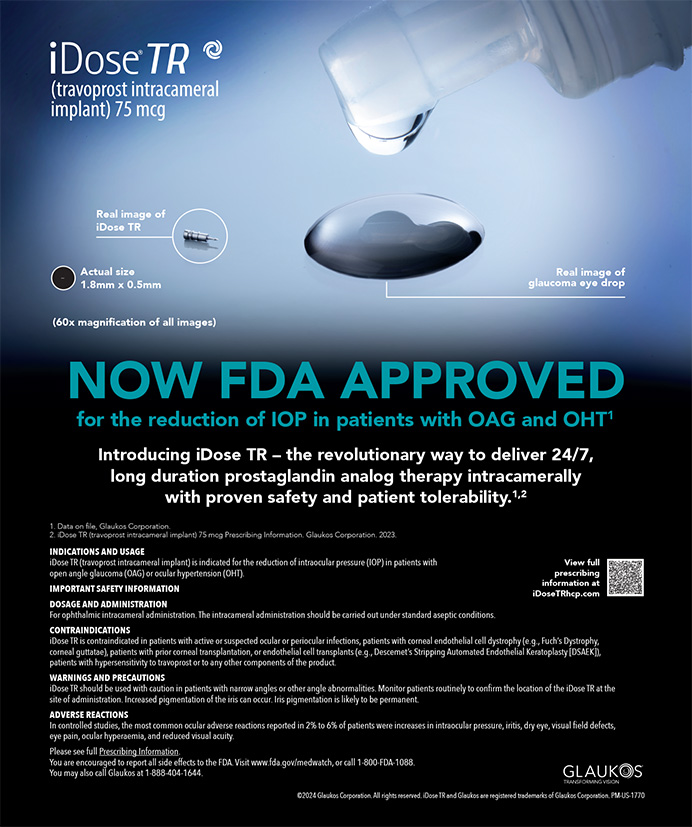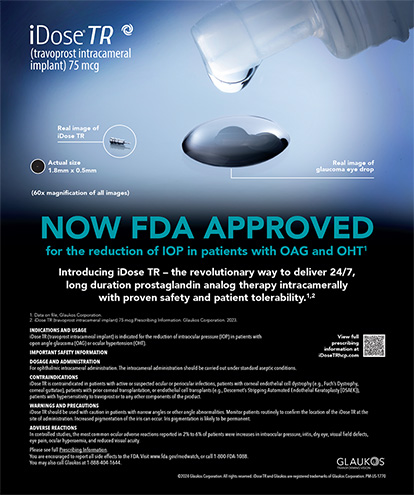Although presbyopia-correcting IOLs and monovision have the greatest likelihood of providing patients with spectacle independence after cataract surgery, the majority of candidates choose neither of these options. Instead, surgeons typically target a bilateral plano refractive result, thus enabling patients to read the Snellen acuity chart when it is held 20 feet away. Functionally, this allows patients to drive a car without spectacles, but it forces them to wear reading glasses when performing near tasks. I believe that many patients will obtain a higher level of spectacle independence if I target a low myopic result. I therefore recommend that my fellow surgeons consider this option in their surgical planning instead of automatically targeting plano outcomes.
The world of the pseudophake is divided into three distinct zones: distance (eg, driving, television); intermediate (eg, computer, cooking); and near (eg, reading, sewing). When considering a postoperative refractive target, surgeons have the ability to choose in advance which of these activities their patients will most likely be able to perform without spectacles.
ANALYZING WHEN PATIENTS USE SPECTACLES
In addition to treating medical and surgical diseases of the eye, I see a large number of healthy patients whose only ocular problem is ametropia and/or presbyopia. I will often ask patients how often and for what tasks they wear their glasses. I have found that presbyopic and pseudophakic patients who wear glasses the least amount of hours of the day are those who have approximately 1.00 D of myopia.
Pseudophakic emmetropes tend to wear spectacles for near and intermediate tasks only. Individuals who have vocations or avocations that involve reading, computer work, knitting, solving crossword puzzles, etc., may wear their glasses quite frequently. In fact, an emmetropic, pseudophakic attorney or accountant may use his reading glasses 8 to 10 hours a day while working and only take them off to drive to and from work. He may then put his glasses back on at home while he eats dinner, reads the newspaper, and checks e-mail. It may be surprising, but this pseudophakic patient may in fact be wearing glasses the overwhelming majority of his waking hours, despite the emmetropic result.
Pseudophakes with a refractive error of approximately -1.00 D have clear intermediate vision, allowing them to easily use a computer, eat or cook a meal, read the newspaper, see items on shelves while shopping, and play the piano without glasses. Many use reading glasses only to read small print (eg, pill bottles) or in poor lighting conditions (eg, to see menus in dimly lit restaurants). Because pseudophakic patients have a low level of myopia, they can usually drive a car legally without spectacles, often wearing glasses only to drive at night. Instead of buying expensive multifocal glasses, many of these patients are content to use one pair of single-vision prescription glasses for driving and a separate pair of low-plus "dime store" glasses for reading.
OFFERING AN ALTERNATIVE TO EMMETROPIA
We cataract and refractive surgeons have expanded our preoperative consultations to include discussions of phakic, toric, accommodating, and multifocal IOLs. For the sake of completeness, I believe that we can better serve our patients' needs by reviewing the option of targeting a low degree myopia in both eyes after cataract surgery. I have found that the ideal myopic target is around -1.00 D, and I will often target -0.75 D in the dominant eye and -1.25 D in the nondominant eye to increase the depth of focus.
As with any such preoperative discussion, surgeons should emphasize functional vision and try to minimize using terms such as near-sighted or myopia. I have found it best to concentrate on how many hours patients spend doing specific activities and which ones they would most like to perform without glasses. Often, the discussion is as simple as asking, "Which would you rather be able to do without glasses, drive or use a computer?"
The patients who achieve the most success with targeted low myopia are those who are still working, specifically those who spend a lot of time on a computer. Also, I reserve this option for patients who do not desire either monovision or a presbyopia-correcting IOL.
In summary, presbyopic patients with low myopia are often less dependent upon spectacles than emmetropic ones. Surgeons who successfully incorporate this option into their practices will find patients' satisfaction very high, and they will often offer it to their presbyopic patients undergoing keratorefractive procedures such as LASIK, PRK, and conductive keratoplasty.
Gary S. Schwartz, MD, is in private practice at Associated Eye Care in St. Paul, Minnesota. He may be reached at (651) 275-3000; gsschwartz@associatedeyecare.com.


